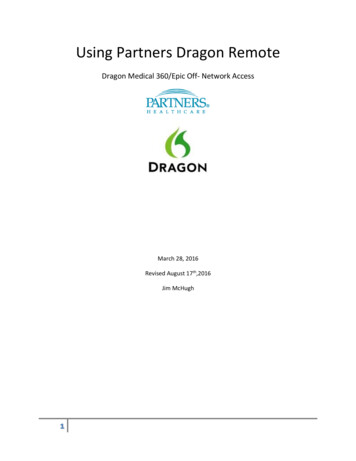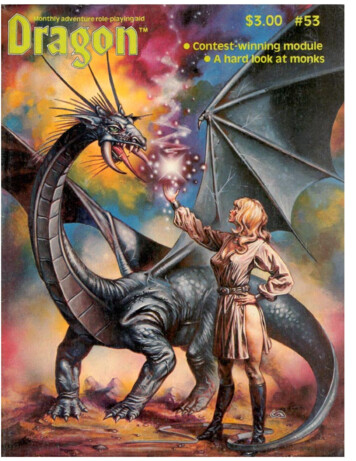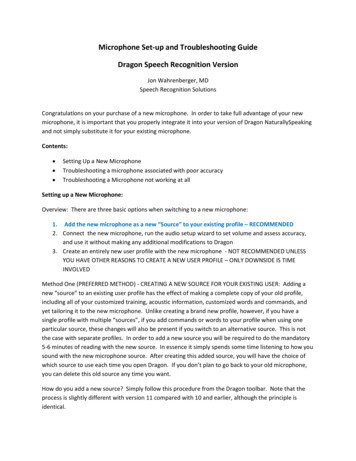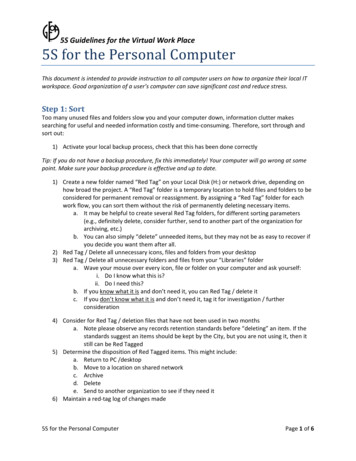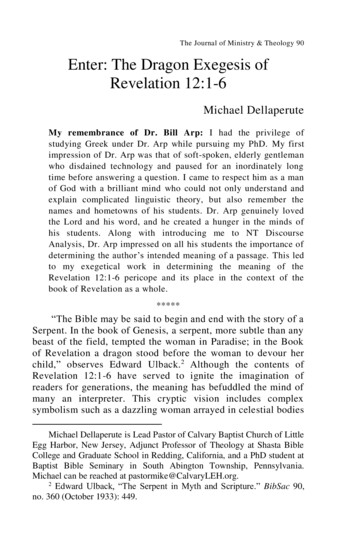
Transcription
The Journal of Ministry & Theology 90Enter: The Dragon Exegesis ofRevelation 12:1-6Michael DellaperuteMy remembrance of Dr. Bill Arp: I had the privilege ofstudying Greek under Dr. Arp while pursuing my PhD. My firstimpression of Dr. Arp was that of soft-spoken, elderly gentlemanwho disdained technology and paused for an inordinately longtime before answering a question. I came to respect him as a manof God with a brilliant mind who could not only understand andexplain complicated linguistic theory, but also remember thenames and hometowns of his students. Dr. Arp genuinely lovedthe Lord and his word, and he created a hunger in the minds ofhis students. Along with introducing me to NT DiscourseAnalysis, Dr. Arp impressed on all his students the importance ofdetermining the author’s intended meaning of a passage. This ledto my exegetical work in determining the meaning of theRevelation 12:1-6 pericope and its place in the context of thebook of Revelation as a whole.*****“The Bible may be said to begin and end with the story of aSerpent. In the book of Genesis, a serpent, more subtle than anybeast of the field, tempted the woman in Paradise; in the Bookof Revelation a dragon stood before the woman to devour herchild,” observes Edward Ulback.2 Although the contents ofRevelation 12:1-6 have served to ignite the imagination ofreaders for generations, the meaning has befuddled the mind ofmany an interpreter. This cryptic vision includes complexsymbolism such as a dazzling woman arrayed in celestial bodiesMichael Dellaperute is Lead Pastor of Calvary Baptist Church of LittleEgg Harbor, New Jersey, Adjunct Professor of Theology at Shasta BibleCollege and Graduate School in Redding, California, and a PhD student atBaptist Bible Seminary in South Abington Township, Pennsylvania.Michael can be reached at pastormike@CalvaryLEH.org.2Edward Ulback, “The Serpent in Myth and Scripture.” BibSac 90,no. 360 (October 1933): 449.
Enter: The Dragon Exegesis of Revelation 12:1-6 91who births a son; the mysterious removal of the man-childdestined to rule the nations; and a multi-headed dragon with aferocious appetite and a tail powerful enough to dislodge starsfrom their heavenly abode. Yet the author’s single, intendedmeaning of the passage is both attainable and foundational forunderstanding the ensuing events of the Apocalypse.Textual CriticismThe passage that innocently begins with the clause Καὶσημεῖον μέγα ὤφθη ἐν τῷ οὐρανῷ (Rev 12:1, UBS4) ends withthe statement: καὶ ἐστάθη ἐπὶ τὴν ἄμμον τῆς θαλάσσης (Rev12:18, UBS4). 3 The treatment of this final clause is a matter ofcontention among modern translations. 4 Several witnessesreplace ἐστάθη with ἐστάθην, including the Majority Text andthe Vulgate. 5 However, the presence of this variant can beexplained by reasoned eclecticism. 6 Internally, the third personsingular is initially given preference over the first personsingular due to the shorter and more difficult reading axioms. 7Furthermore, the inclusion of the first person singular endingcan be explained as either an unintentional addition due to the3Revelation 12:1-13:18 is a literary unit that stands in apposition toRevelation 14:1-13. The opening of the temple in Revelation 11:19 servesto introduce the section, and the two visions of Revelation 14:14-20 draw itto a close.4The ESV attaches the clause “And he stood on the sand of the sea” tothe end of 12:17. The NET creates an additional verse and adds the referent“And the dragon stood ” (12:18). The NASB also inserts the clarifier“The dragon,” but places the clause in 13:1. The NKJV also places theclause at the beginning of chapter 13, but interprets it according to thevariant “Then I stood. ” This sampling demonstrates the difficulty thispassage has caused.5New English Translation Novum Testamentum Graece Greek textand critical apparatus Nestle-Aland (Dallas, Deutsche Bibelgesellschaft:2004), 656.6Daniel Wallace, “Laying a Foundation: New Testament TextualCriticism,” in Interpreting the New Testament Text, ed. Darrell Bock andBuist Fanning (Wheaton, IL: Crossway, 2006, 45). Reasoned eclecticism isa balanced approach that “treats external and internal evidence equally.”7Ibid., 46-47.
92 The Journal of Ministry & Theologyproximity of τὴν or as an intentional attempt by a copyist toforce ἐστάθην to agree with εἶδον (Rev 13:1). 8 Externally,credible witnesses that support the third person singular readinginclude Papyrus 47, Aleph, A, and C. 9 Finally, a grammaticalanalysis of the passage would assign either ὁ δράκων as theantecedent of ἐστάθη or the author as the antecedent ofἐστάθην.10 Contextually, the use of the coordinate conjunctionκαὶ in the subsequent clause grammatically links the events ofRevelation 12 to the events of Revelation 13, indicating that therise of the beast ἐκ τῆς θαλάσσης is initiated by the one whostood ἐπὶ τὴν ἄμμον τῆς θαλάσσης. Accordingly, the contents ofRevelation 12:1-6 serve to introduce the dragon as the primaryantagonist of humanity, a theme that is continued in Revelation13. This is the ancient serpent (Rev 12:9) who instigated theconflict in Genesis 3 and will ultimately be crushed by JesusChrist when he returns (Rev 19:11ff). The sinister events thatfollow are set in motion by this ancient enemy of mankind, asrevealed to John in epic form. Therefore, on to the scene of theapocalypse, enter: the dragon.Genre AnalysisNo academic consensus exists regarding the literary form ofRevelation. Because the author introduces his work with theterm ἀποκάλυψις (Rev 1:1) and later describes it as προφητείας(Rev 1:3), the two most common genres assigned to Revelationare apocalyptic and prophecy. These labels are typicallyemployed either independently or collectively, and they arenormally implemented to defend the use of allegory orintertestamental literature as exegetical tools. 11 Collins provided8G. K. Beale, The Book of Revelation, NIGTC (Grand Rapids:Eerdmans, 1999), p. 681.9Ibid.10ὁ δράκων of 12:3ff is the central character of the narrative. Theauthor plays a passive role in this passage.11Grant Osborne, The Hermeneutical Spiral, 2nd ed. (Downers Grove,IL: IVP, 2006), 284. Osborne identifies apocalyptic intertestamentalliterature as a major interpretative source. Walvoord explains the use of
Enter: The Dragon Exegesis of Revelation 12:1-6 93the foundation for the classification of the apocalyptic genre bycomparing the recurring characteristics of late antiquity easternMediterranean writings. 12 His seminal views on apocalypticgenre have been developed by recent scholarship. Bandy states,“The book of Revelation belongs to the apocalyptic/propheticgenre, and the apocalyptic genre by definition is highlysymbolic. It is not intended to be interpreted in a literalmanner.”13 Beale concurs with Brandy, initially definingRevelation by “the three genres of apocalyptic, prophecy, andepistle”14 before ultimately labeling the literary sub-genredubbed “Apocalyptic-prophetic.” 15 In contrast, Thomas rejectsboth the apocalyptic label and the subsequent hermeneutics thataccompany it, electing instead for a “Visional-prophetic” subgenre.16The concerted efforts of form critics to identify the literaryform of Revelation with either ἀποκάλυψις or προφητείας haveallegory (The Revelation of Jesus Christ: A Commentary [Chicago:Moody, 1966], 16).12John Collins, “Introduction: Towards the Morphology of a Genre,”Semeia, no.14 (1979): 5. Collins ultimately defines apocalyptic as “a genreof revelatory literature with a narrative framework, in which a revelation ismediated by an otherworldly being to a human recipient, disclosing atranscendent reality which is both temporal, insofar as it envisageseschatological salvation, and spatial insofar as it involves another,supernatural world” (9).13Alan Bandy, “The Hermeneutics of Symbolism: How to Interpretthe Symbols of John’s Apocalypse,” SBJT 14, no.1 (Spring 2010): 48.Although Bandy accurately identifies the symbols of Revelation as visualmetaphors, his genre-driven hermeneutic forces him into to allegoricalconclusions.14Beale, Book of Revelation, 37. Beale rightly notes the “epistolaryform” of Revelation stating, “This book both begins and concludes intypical epistolary manner” (38-39). Therefore, at minimum, the argumentcan be made that Revelation is a conglomerate of narrative, prophetic,apocalyptic, and epistolary genres. Beale finally appeals to Carson, Moo,and Morris’s identification of Revelation’s genre as “a prophecy cast in anapocalyptic mold and written down in letter form” (Ibid.).15Ibid., 38.16Robert Thomas, Revelation 1-7: An Exegetical Commentary(Chicago: Moody, 1992), 29.
94 The Journal of Ministry & Theologyresulted in anachronistic use of both words. Neither noun wasoriginally implemented by the author of Revelation to identifythe literary genre of his work. The nominative absolute phraseἈποκάλυψις Ἰησοῦ Χριστοῦ actually introduces the author’ssubject. 17 This phrase serves as the title of the book, rather thana revelation of the author’s literary form. And, as Collinsironically notes, “The title is not a reliable guide to the genre.” 18Stronger support for genre identification could be garneredfrom the phrase τοὺς λόγους τῆς προφητείας, which is utilizedby the author in order to appeal to divine authority. 19 Therefore,while recognizing that classifying Revelation as any genre is ahighly speculative exegetical decision, this article will approachRevelation as a prophetic book of Scripture.Exegetical MethodThe prophecy of Revelation was communicated through aseries of visions that are introduced with the aorist verbἐσήμανεν (Rev 1:1). 20 These visions contain highly symboliclanguage that is challenging to decipher. Fruchtenbaumidentifies two extreme, errant approaches to interpreting thesymbols of Revelation. The first, which assumes that the bookcannot be understood, results in idealism; while the second,which ascribes the symbols to “unchecked speculation” results17Daniel Wallace, Greek Grammar Beyond the Basics (GrandRapids: Zondervan,. 1996), 50, 120-21. Wallace identifies Ἰησοῦ Χριστοῦas a plenary genitive, making the entire phrase the title, and Christ thetheme.18Collins, “Introduction,” 2. If Collins’s definition of apocalypticgenre is to be given credence in modern scholarship, then so should hismethod of application.19BAGD, 722. BAGD identifies this term as “Utterances by Christianprophets.” Wallace identifies this as a genitive of apposition, functioningepexegetically (Greek Grammar, 95-99). To assign a literary form ofeither prophecy or apocalyptic to this text based on these words would bean anachronistic fallacy.20Beale, Book of Revelation, 50-51. Beale stresses the “symboliccommunication” nuance of the root.
Enter: The Dragon Exegesis of Revelation 12:1-6 95in sensationalism. 21 Defining a consistent hermeneutic methodto interpret the symbols of Revelation is essential for accurateexegesis.There are six exegetical guidelines to interpreting thesymbols of the Apocalypse. First, all symbols in Revelation willbe treated as metaphors. Osborne asserts that meaning of thesemetaphors is, “Found in the use of that symbol in its ancientsetting.” 22 This principle restricts the expositor to identifyingthe author’s intended meaning for each symbol, therebypreventing sensationalism. Second, Bandy affirms that“Symbols are intended to reveal meaning rather than concealit.”23 Not only does the author intend to convey a singlemessage with each symbol in Revelation, but the meaning ofeach symbol is attainable. Application of this principlesatisfactorily addresses the idealistic fringe of interpretation.Third, Thomas notes that a normal, grammatical historicalmethod of interpretation must be applied to all Scripture.However, Thomas argues that this method must retain “adistinction between symbols and figurative language.” 24 Such aliteral approach will recognize that the symbols in Revelation12:1-6 are intended to communicate a message whilemaintaining that the author is conveying the contents of anactual vision. Fourth, when the author of Revelation assigns ameaning to a symbol anywhere in Revelation, that symbol mustbe consistently interpreted by the author’s guidelineseverywhere in Revelation. For example, in Revelation 12:1-6, ὁδράκων is identified as ὁ Σατανᾶς (Rev 12:9) and τῶν ἀστέρωντοῦ οὐρανοῦ are identified as οἱ ἄγγελοι αὐτοῦ (Rev 12:9). 25These symbols must be consistently interpreted throughout theApocalypse. Fifth, when the author of Revelation does notArnold Fruchtenbaum, “The Use of the Old Testament in the Bookof Revelation,” Chafer Theological Seminary Journal 13, no. 1 (Spring2008): 28.22Osborne, Hermeneutical Spiral, 283.23Bandy, “Hermeneutics of Symbolism,” 49.24Thomas, Revelation 1-7, 35-38.25John F. Walvoord, The Revelation of Jesus Christ (Chicago: Moody,1966), 29. Also, Bandy, “Hermeneutics of Symbolism,” 49-51.21
96 The Journal of Ministry & Theologyexplain the meaning of a symbol, Scripture must interpret thatsymbol. Although scholars disagree on the exact number of OTallusions in Revelation, most acknowledge that the OT isreferenced hundreds of times throughout the book. 26 Theauthor’s consistent appeal to the OT coupled with his theme ofChrist’s return makes the OT and the gospels the primary toolsfor interpreting the symbols of Revelation. Finally, the readermay only search beyond the bounds of Scripture for themeaning of a symbol when instructed to do so by the author(Rev 13:18; 17:9). This final principle precludes thedependence on zodiac charts, intertestamental apocalypticliterature, or even current events to interpret Revelation. 27Theological ApproachThere are several competing theological approaches thatinfluence the interpretation of Revelation. These include thepreteristic, idealistic, historistic, futuristic, and eclecticviewpoints.28 Preterism approaches Revelation with thepresupposition that the text describes events that have beenfulfilled in the first century. 29 Adherents to the idealistic schoolview Revelation as a “symbolic portrayal of the conflictbetween good and evil.”30 Both methods consider Revelation “ahighly figurative book that we cannot approach withstraightforward literalism.” 31 Historicism perceives RevelationFruchtenbaum,”Use of the OT,” 28. Fruchtenbaum identifies about550 allusions. Thomas notes, “Of the 404 verses in the Apocalypse, 278allude to the OT Scripture” (Revelation 1-7, 40).27Walvoord, Revelation, 27.28Charles Ryrie, Revelation (Chicago: Moody, 1966), 8-10. Althoughthis list is not exhaustive, these first four approaches are representative ofthe major theological views of Revelation. See also Beale who combineselements of several traditional viewpoints into an “eclectic approach”(Book of Revelation, 44-50).29Kenneth Gentry, “A Preterist View of Revelation,” in Four Viewson Revelation, ed. Stanley Gundry and Marvin Pate (Grand Rapids:Zondervan. 1998), 37.30Beale, Book of Revelation, 48.31Gentry, “Preterist View,” 38.26
Enter: The Dragon Exegesis of Revelation 12:1-6 97as “a panorama of church history from John’s time until thesecond advent.” 32 Meanwhile, the futurist interprets Revelation“very literally and generally sees the order of the vision asrepresenting the historical order of future events.” 33Furthermore, futurists interpret the body of Revelation (Rev4:1-19:10) as describing the events of the tribulation. Thetribulation is a future seven-year period of judgment on earthdirectly pertaining to Israel, immediately preceding the returnof Jesus Christ, and developed from Daniel 9:24-27. eDispensationalism,” 34 or Beale’s “Redemptive-Historical Formof Modified Idealism,” 35 attempt to blend elements of the firstfour approaches into one theological system. Following Thomasas a result of “sufficient recognition to the prophetic style of thebook and a normal hermeneutical pattern of interpretation basedon that style,” 36 this paper will approach Revelation from afuturistic perspective. The theological approach of the expositorwill have profound implications on the outline andinterpretation of the book.OutlineDue to conflicting theological approaches and genreassignments, the structure of Revelation has suffered fromexegetical ailments of chias-o-mania and hept-o-mania incontemporary scholarship. Both of these fallacies appeal toform criticism and theological presuppositions for theirstructural support. Chias-o-mania describes the growing trendin contemporary scholarship to redact a verse, passage, chapter,or even book into a chiastic outline. Lee’s twenty-point outline32Thomas, Revelation 1-7, 30.Beale, Book of Revelation, 47. Beale ascribes this term todispensational futurism and notes the section of Revelation 4:1-22:5.34Marvin Pate, “A Progressive Dispensational View of Revelation,” inFour Views on Revelation, 140.35Beale, Book of Revelation , 48.36Thomas, Revelation 1-7, 32.33
98 The Journal of Ministry & Theologyof Revelation typifies this practice. 37 Lee utilizes an eclectictheological approach to construct her chiasm, combiningfuturist, idealist and feminist theology in order to create aparallel between the events of Revelation 13 and the events ofRevelation 14 at the center of her model.38 Lee is then forced topair Revelation 12:1-6 with Revelation 17:1-6. Lee is able tojustify her exegetical decisions by identifying the woman as theprimary character of Revelation 12:1-6.39 However, as a resultof her structural approach, the dragon gets lost in Lee’s chiasm.Akin to Chias-o-mania is propensity of hept-o-mania. Hepto-mania is an academic fallacy that forces the structure ofRevelation into an unnatural series of seven. Painter’s outline ofRevelation as four series of sevens set between a prologue andan epilogue is a prime example of hept-o-mania in modernscholarship. 40 In order to validate his outline, Painterincorporates an eclectic theological approach, implementingboth historicist and idealistic elements into his exegeticaldecisions. Painter places the co-text Revelation 12:1-6 withinthe context of the seven trumpet judgments, therebygrammatically linking these judgments to the churches ofPergamum and Laodicea. 41 As a result of Painter’s heptamological outline, the dragon gets buried in history.The preceding critiques of chias-o-mania and hept-o-manianeither intended to deny the fact that chiasms exist in ScriptureMichelle Lee, “A Call to Martyrdom: Function as Method andMessage in Revelation.” NovT 40, no. 2 (April 1998): 174. Lee and Painterare intended to be representative of a trend in modern exegesis.38Ibid., 178. This represents the heart of Lee’s outline for Revelation,“the moment of decision.”39Ibid., 178-79. Not only is the woman elevated to the position ofmain character of the narrative, but the dragon is absent from Lee’s outline.By redacting the dragon and placing the woman of Revelation 12:1-6 inapposition with the prostitute of Revelation 17:16, Lee sacrifices meaningon the altar of form. This author asserts that the prostitute of Revelation17:1ff actually stands in apposition with the bride of Revelation 19:7ff.40John Painter, “The Johannine Literature, ” in A Handbook to theExegesis of the New Testament, ed. Stanley Porter (Boston: Brill, 2002),559-62.41Ibid.37
Enter: The Dragon Exegesis of Revelation 12:1-6 99nor to encourage expositors to ignore the thematic use of thenumber seven in Revelation. Instead, they illustrate the fallacyof imposing a preconceived structure onto the text. In contrastto these contrived outlines, Walvoord develops his outline fromthe text of Revelation 1:19, explaining that, “The advantage ofthis outline is that it deals in a natural way with the materialrather than seizing on incidentals.” 42 Beale and Thomas alsonote the significance of Revelation 1:19 when constructing anoutline of the book. Beale utilizes an eclectic theologicalapproach and genre criticism to apply this verse to Daniel2:28.43 Conversely, Thomas implements a futuristic approachin order to capture the “telescopic arrangement” of thejudgments as they unfold in a linear pattern. 44 Due to itssimplistic structure, this paper will develop an outline based onRevelation 1:19, utilizing a futuristic approach first developedby Ryrie as follows: 45I. The things that you have seen (1:1-20)A. Prologue (1:1-11)B. Vision of Christ (1:12-18)C. Command to write (1:19-20)II. Those that are (2-3)III. Those that are to take place after this (4-22).A. Heavenly interlude (4-5)B. The tribulation (6:1-19:10)C. The return and reign of Christ (19:11-20:15)D. The eternal kingdom (21:1-22:5)E. Epilogue (22:6-21)Author and DateThe author identifies himself as Ἰωάννῃ four times in thebook of Revelation (1:1, 4, 9; 22:8), leaving consistentexpositors such as Robertson to conclude that “the traditional42Walvoord, Revelation, 48.Beale, Book of Revelation, 152ff.44Thomas, Revelation 1-7, 43.45Ryrie, Revelation, 11.43
100 The Journal of Ministry & Theologyand obvious way to understand the name is the Apostle John.” 46Early church writers including Irenaeus, Justin Martyr, Clementof Alexandria, Hippolytus, and Origen support this view. 47Irenaeus testified that the apostle John wrote Revelation whilebanished on Patmos during Domitian’s reign, which isconsistent with the author’s testimony in Revelation 1:9. 48Dionysius of Alexandria issued the first recorded challenge tothe identity of the author in the middle of the third century AD,and speculations have since abounded. 49 Due to thepseudonymous nature of intertestamental apocalyptic literature,contemporary scholarship tends to follow Dionysius’ lead andattribute the authorship of Revelation to someone other than theapostle John. 50 Furthermore, preterism rejects a late date ofwriting on theological grounds, requiring an early date as afoundation for its theological system. 51 However, if the text ofRevelation and the historical church witness is to be given anycredence, then all evidence supports the apostle John authoringthe book of Revelation circa AD 90-95.52Literary ContextRevelation 12:1-6 contains the first two of seven signs inthe book of Revelation. 53 This pericope is set within the contextof the future, seven-year period of tribulation. From the onset ofthe tribulation, events that are initiated in heaven (Rev 4-5)transpire on earth (Rev 6). John uses οὐρανῷ seven times and46Archibald Thomas Robertson, Word Pictures in the New Testament,vol. 6 (Grand Rapids: Baker, 1933 , 272.47Alan Johnson, Revelation, in The Expositor’s Bible Commentary,ed. Frank Gaebelein (Grand Rapids: Zondervan, 1981), 404.48Ryrie, Revelation, 8-9.49Thomas, Revelation 1-7, 2-11. This author recognizes thecontemporary debate between BC/AD and BCE/CE and deliberatelychooses to implement the Anno Domini system over the Common Erasystem.50Painter, “Johannine Literature,” 557.51Thomas, Revelation 1-7, 30.52Walvoord, Revelation, 12-14.53Ryrie, Revelation, 89.
Enter: The Dragon Exegesis of Revelation 12:1-6 101γῆν six times in Revelation 12 to emphasize the interplaybetween heaven and earth. At the conclusion of Revelation11:15-19, the final trumpet judgment sounds, commencing thefinal seven bowl judgments of Revelation 16. These bowljudgments culminate with the return of Christ in Revelation19:11ff. However, before these judgments are unleashed, Johnis shown a vision that contributes valuable backgroundinformation to the events that are about to transpire. Revelation12:1-6 introduces the primary antagonist of the tribulation,briefly recounting his nefarious activity in history (Rev 12:1-5)before revealing his violent plans for the future (Rev 12:6ff).The dragon of Revelation 12 is unveiled as the ancient enemyof the human race. The same serpent that once tempted thewoman in Eden will one day persecute the “woman” in thefuture. The dragon that attempted to usurp Christ will ultimatelycause the rise of the antichrist. The events of Revelation 12:1 -6serve to recount the dragon’s movements throughout historyand into the future as he briefly experiences limited authorityupon the earth.Original TranslationAnd then an incredible sign appeared in heaven: A womanwas wearing the sun, and the moon was beneath her feet, and awreath of twelve stars was upon her head! And being verypregnant, she cried out in agony with contractions, indicatingthat she was about to give birth. And then another sign appearedin heaven: First behold, a great, fiery red dragon with sevenheads, and with ten horns, and with seven crowns upon hisheads! Then his tail dragged away one third of the stars ofheaven and cast them down to the earth. Next, the dragon stoodin front of the woman who was about to give birth, because heintended to devour her child as soon as she gave birth to him.Then she gave birth to a man-child, the one who is destined toshepherd all nations with an iron staff. Next, her child wassuddenly snatched away to God and to his throne. And finallythe woman fled into the wilderness where a place has beenprepared for her by God in order that they might sustain her for1260 days.
102 The Journal of Ministry & TheologyGrammatical AnalysisJohn introduces Revelation 12 with the clause: Καὶ σημεῖονμέγα ὤφθη ἐν τῷ οὐρανῷ. The use of καὶ as a coordinateconjunction grammatically links this statement to the precedingclause as the author continues to narrate events with a linearthought process. John had just witnessed the temple of Godbeing opened ἐν τῷ οὐρανῷ where several signs were ὤφθη tohim, including the ark, lightning, a voice, thunder, anearthquake, and hail (Rev 11:19). These signs are reminiscentof John’s initial throne-room vision that initiated theTribulation (Rev 4:5). The perfective aspect of the aorist ὤφθηprovides the background for the narrative. Furthermore, the useof ὤφθη, as opposed to John’s standard introductory phrasesΜετὰ ταῦτα εἶδον (Rev 4:1) or καὶ εἶδον (Rev 13:1), isemphatic. 54John summarizes the symbols of Revelation 12 as σημεῖονμέγα, further underscoring the magnitude of the vision that isabout to transpire with an emphatic adjective. 55 This event is thefirst heavenly sign in Revelation to be modified with μέγα,indicating its unique status (Rev 13:3, 15:1). 56 The incrediblesign that appeared in heaven is part a scene that unfolds beforeJohn’s eyes, beginning with a γυνὴ. This γυνὴ is the second offour women in the book of Revelation, all of which aresymbolic.57 Theologians have long debated the identity of thewoman of Revelation 12. As early as the third century,Hippolytus identified the woman as “the church,” a label thatmany modern theologians have embraced. 58 Oecumenius, who54Robertson, Word Pictures, 387.BAGD 497. μέγα stresses the intensity and importance of thesubject, not just the size.56Robertson, Word Pictures, 387. Considering all the signs andsymbols John has witnessed up to this point in the Apocalypse, thesignificance of this adjective is accentuated by translating it as“incredible.”57Ryrie, Revelation, 89. The three other symbolic women are Jezebel(Rev 2), the harlot (Rev 17), and the bride (Rev 19).58William Weinrich and Thomas Oden, Ancient ChristianCommentary on Scripture, New Testament, XII, Revelation (Downer’s55
Enter: The Dragon Exegesis of Revelation 12:1-6 103represents the dominant theological mindset of the medievalera, maintained that the woman symbolized “the mother of ourSavior.”59 Contemporary scholarship has further complicatedthe issue by attempting to interpret apocalyptic symbols withpagan mythology like Apollo and the Python; or by utilizing thezodiac to relate the woman to the constellation Virgo and thedragon to the constellation Hydra. 60 Finally, throughout history,expositors of the Apocalypse have also maintained that thewoman represents Israel. 61Applying a consistent hermeneutic method to the symbol ofthe pregnant woman will result in identifying her as Israel.Since the text of Revelation does not reveal the identity of thewoman, interpreting this vision is dependent upon comparingher description with Scripture. First, the symbol of a pregnantwoman is used throughout the OT to refer to Israel (Isa 66:7-8;Jer 4:31; Mic 4:9-10).62 Second, the threefold symbolsassociated with the woman include τὸν ἥλιον ἡ σελήνη ,and στέφανος ἀστέρων δώδεκα. These symbols refer the readerback to Genesis 37:9-11, where Beale observes, “The sun,moon, and eleven stars are metaphorical respectively for Jacob,his wife, and the tribes of Israel.” 63 Finally, the symbolicactivities associated with the woman include ἔτεκεν υἱὸν ἄρσεν and ἔφυγεν εἰς τὴν ἔρημον. The fact that the woman begetsthe child precludes the woman from being identified as thechurch, since Fruchtenbaum rightly maintains, “It would be ananachronism: the church would have to give birth to theMessiah, when in fact the opposite is true.” 64 The action of thewoman fleeing alone into the wilderness for a specific timeGrove: IVP, 2005), 173. For a contemporary example, see Beale, Book ofRevelation, 631.59Ibid., 175.60Ulback, “Serpent,” 450-55. See also Beale, Book of Revelation, 62627.61Johnson, Revelation, 513-14.62Dwight Pentecost, Things to Come (Grand Rapids: Zondervan.1958), 288.63G. K. Beale and D. A. Carson, Commentary of the New TestamentUse of the Old Testament (Grand Rapids: Baker, 2007), 1123.64Fruchtenbaum, “Use of the OT,” 34. See also Matthew 16:18.
104 The Journal of Ministry & Theologyperiod precludes her from being identified as Mary, since Marywas never persecuted in this manner. 65 Therefore, theapplication of a consistent hermeneutic approach that utilizesScripture to interpret symbols of Revelation restricts theidentification of the woman as a metaphor for Israel. 66After describing the woman, John continues his linearthought process with the phrase καὶ ὤφθη σημεῖον ἐν τῷοὐρανῷ, connecting the subsequent vision with the precedingone.67 However, instead of describing a σημεῖον μέγα, Johndescribes a δράκων μέγας. A general
Sep 05, 2018 · Revelation 14:1-13. The opening of the temple in Revelation 11:19 serves to introduce the section, and the two visions of Revelation 14:14-20 draw it to a close. 4 The ESV attaches the clause “And he stood on the sand of the sea” to the end of 12:17. The NET creates an additional verse
